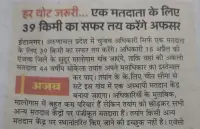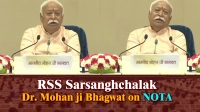Role of so-called Non Kshatriya Jaatis esp from Non-Brahmin Jaatis Leading in Battles for Hindu Revival
Many a times, varna and jaati are mixed. It would surprise one to know that nowhere in our texts is there mention of Vaishya jaati. Vaishya is a varna ( people who wanted to expand business ) . They came from all jaatis and since they were basically engaged in selling in outside lands for which they had to travel long periods, sometimes for over 2 years, they went along in groups of families.
In later period, this may have got stratified. For example, even though Marwari sounds like a jaati, it simple means those that belong to area of Marwar. Since most of them were engaged in business, they got identified with vaishya community. However, there are Marwaris of various jaatis.
Similarly, while some jaatis were entrusted with the role of protection ( kshatriyas ), there are numerous examples of other jaatis who came to occupy the role of the kshatriya and also won many battles against trained Muslim armies. This would not have been possible had they not been trained in war strategy and tactics.
2. Barwaris, a scheduled caste jaati involved in leather cleaing – In 1299, Barwaris of Gujarat rose in revenge of the sack of Gujarat and helped Khusrau Khan in planning and excution of Qutubuddin. Khusrau was a forcible Muslim covert at but still retained Hinduness at heart. . Khusrau Khan changed his name to Khusrau Shah began workship of vigrahas in Delhi, forbade cow slaughter. Over 40,000 barwaris marched into Delhi and their leader was annointed a general by Khusrau Shah
3. Khokkars were an agricultural tribe and they lead a resistance for over 250 years. They tenaciously opposed Muhammad Ghori and eventually killed him. They even had taken over Lahore.
4. Gonds were also an agricultural community or worked in forests. They had their own systems of rulership and were called Rajas. Rani of Gondwana – Durgavati, Raja of Garha Garola, Harya, Salwani, Manola, Lanji continued their battle. An Agrarian jaati which took up the role of Kshatriyas.
5. Bhils a tribe support to Rana Pratap. Because of them the chiefs of Marwar were never short of manpower. It must be noted that during their ascension, evey Rajput chiefs to be marked on the brow with the blood of Bhils. The state emblemn of Rana Pratap bore the Bhils on it as a testimony their bravery. After his loss at Haldighati, Rana regrouped and n all his forts except Chittor, Ajmer and Mandalgarh. Pratap’s army also had chieftains from Bhil community trained in strategy and tactics. Rana’s army comprising of majority Bhils succeeded in winning many battles of so-called disciplined Muslim forces. Without training in military warfare of the Bhils, would Rana be able to regain those sites.?
6. Satnamis – A Chamar sect was an offshoot of the Raidasis. They followed agriculture and trade on small scale. 5000 Satnamis fought Aurangzeb’s army. He had to send out additional force of 10000 soldiers to coutner them in 1672.
7. Jats, Marathas and Sikhs – Jats were mostly peasants who fought continuous battles from 1661. Raja Ram and Ram Chehra, zamindars of Sinsani and Sogar assumed leadership of Jats in 1685. They builds small forts and trained the peasants in warfare. They killed Mughal warrior Aghar Khan and then attacked Mahabat Khan and marched into Punjab. They also plundered Akbar’s tomb.
It must be noted that Jats, the Marathas and most of the Sikh warriors came from backward classes since the struggle was given up by the Rajputs. Surajmal rose to the position of a Raja and spearheaded the struggle in Agra-Mathura. Marathas were also among backward castes.
Sivaji himself was from a Kunbi jaati. Kunbis are basically agrarian community who over a period of time took up kinship. Sivaji was also trained by Dada Kondadev, guided by Samartha Ramdas and his army consisted of generals like Tanaji Malsure, yeshaji Kank and many other generals who were from so-called non Kshatriya jaatis ); took up the role of Kshatriyas.
While there was resistance to him assuming the name of Chatrapati, it must also be remembered that the coronation was presided over by Gaga Bhatt, a Brahmin from Varanasi who convinced those who opposed his coronation.
It was after their sustained prowess that the Marathas and Sikhs were considered as martial segments of Hindu society.
8. Oraons – Oraons are also known as Kol which is a generic name for Munda, Ho and Oraon tribes of Chota Nagpur and Santhal paraganas. The Oraons defeated Jahangir and their victory is even today celebrated as Jani Shikar.
9. Reddi Rajas – After the defeat of the kshatriya clans, the Andhra Reddis took over the task. Raja Vema regained the agraharas from the mlechas. An inscription by Singaya-Nayaka clearly proclaims the pride that they took in defending the country when the kshatriya clans were vanquished. . Another inscrpition by his cousin Kapaya Nayaka also talks about how they rescued the Andhra kingdom from the Mohammadans.
There are many more such instances of non-Kshatriya clans, taking up the role of Kshatriyas and defending the country as Kshatriyas. Some jaatis remained as Kshatriyas and some other went back to their traditional vocations. It also shows that people from all jaatis had great respect for their own vocation and depending on the situation were trained and were willing to take up the responsibilities of various varnas.
Majority of above material is from Growth of Scheduled Castes & Scheduled Tribes in Medieval India by Sri KS Lal. Get the book here.





Leave a comment